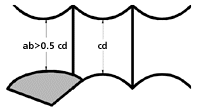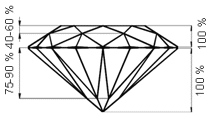| GRADING OF ROUND DIAMONDS ACCORDING TO TU N 25-07.1319-77 | |||||||||||||||||||||||||||||||||||||||||||||||||||||||||||||||||||||||||||
Notes: Diamonds with unique colors (blue, pink, emerald-green, and other rare colors) should be assigned to color grade 1. Diamonds having black color when observed face-up (because of "graphite" inclusions) should be assigned to the last color grade. Correspondence between diamond weight and cutting style.
|
|||||||||||||||||||||||||||||||||||||||||||||||||||||||||||||||||||||||||||
Notes: Diamonds 0.30 ct and more in weight with an extra facet or culet cannot be assigned to the first clarity grade. · Defects in diamond include morphological features (cracks, points, lines, twinning lines, bubbles, clouds, growth lines, inclusions) inherited from the original diamond, mechanic defects produced in the course of cutting, and reflections of defects visible through the table. |
|||||||||||||||||||||||||||||||||||||||||||||||||||||||||||||||||||||||||||
|
|
|||||||||||||||||||||||||||||||||||||||||||||||||||||||||||||||||||||||||||
 The
pavilion facets of diamonds of the Single Cut and Full Cut cutting
styles up to 0.29 ct in weight must have no more than four naturals
and extra facets, and those of diamonds 0.30 ct and more in weight
- no more than two naturals or one natural and one extra facet.
The natural surfaces may have morphological features inherited from
the faces of the original diamond crystal without significant steps
and etch figures. Naturals and extra facets should not affect the
girdle shape in plan and should be observable through the table
in the direction parallel to the symmetry axis of a diamond. The
pavilion facets of diamonds of the Single Cut and Full Cut cutting
styles up to 0.29 ct in weight must have no more than four naturals
and extra facets, and those of diamonds 0.30 ct and more in weight
- no more than two naturals or one natural and one extra facet.
The natural surfaces may have morphological features inherited from
the faces of the original diamond crystal without significant steps
and etch figures. Naturals and extra facets should not affect the
girdle shape in plan and should be observable through the table
in the direction parallel to the symmetry axis of a diamond.
|
|||||||||||||||||||||||||||||||||||||||||||||||||||||||||||||||||||||||||||
 The
girdle of a diamond should be regular in shape and even in thickness
within accepted tolerances. The girdle surface should be clean,
smooth, and mat-gray and should correspond to the girdle surface
of a masterstone. The girdle thickness may vary within 25% between
its minimum and maximum values. For diamonds up from 1.00 ct in
weight, girdle should visually have the same thickness over its
perimeter. The girdle thickness in places where naturals were left
should be less than 50% of the girdle thickness above the adjacent
upper or lower girdle facets. The
girdle of a diamond should be regular in shape and even in thickness
within accepted tolerances. The girdle surface should be clean,
smooth, and mat-gray and should correspond to the girdle surface
of a masterstone. The girdle thickness may vary within 25% between
its minimum and maximum values. For diamonds up from 1.00 ct in
weight, girdle should visually have the same thickness over its
perimeter. The girdle thickness in places where naturals were left
should be less than 50% of the girdle thickness above the adjacent
upper or lower girdle facets.
|
|||||||||||||||||||||||||||||||||||||||||||||||||||||||||||||||||||||||||||
Diamonds with other quality parameters may contain microcracks extending into the stone for no more than 0.05 mm, if the cracked zones (in total or separately) do not exceed 1/3 of the girdle perimeter. Diamonds of Group "B" up from 0.03 ct up to ten per carat witn clarity grade 2 and lower may contain loupe-visible (10x) microcracks over the girdle perimeter, with the cracks extending for no more than 0.07 mm into the stone. |
|||||||||||||||||||||||||||||||||||||||||||||||||||||||||||||||||||||||||||
The culet size should not exceed 2% of the diameter or width of a diamond up to 0.49 ct. in weight and 1% of the diameter or width of a diamond up from 0.50 ct. Diamonds 1.00 ct. and more in weight may have a pointed culet slightly visible at tenfold magnification. The shift of the culet and the table center from the symmetry axis of a diamond up to 0.29 ct. in weight is tolerated within 2% of the diamond diameter or width. For diamonds ranging from 0.30 to 0.99 ct. in weight, the tolerance value is established at 1.5% of the diamond diameter of width. |
|||||||||||||||||||||||||||||||||||||||||||||||||||||||||||||||||||||||||||
Diamonds with any quality characteristics are fashioned according to A-group parameters. B-Group parameters are applied to:
|
|||||||||||||||||||||||||||||||||||||||||||||||||||||||||||||||||||||||||||
|
|||||||||||||||||||||||||||||||||||||||||||||||||||||||||||||||||||||||||||
The crown facets should be exactly above the pavilion facets. For diamonds up to 0.99 ct. in weight, the shift of the crown edges relative pavilion edges is tolerated within: 10% of the base of the upper girdle facet or base of the bezel facet for A-group diamonds; 20% for B-group diamonds All the cutting elements of the crown of a diamond more than 1.00 ct. in weight must be visually symmetrical to those of the pavilion. Curved facets and edges and chips visible at tenfold magnification are not tolerable. The facet surfaces should be carefully polished. The surfaces must not show any traces of graphitization, , lines, scratches, and other fashioning defects visible at tenfold magnification, except for diamonds weighing less than 0.30 ct. (clarity grade 8) and diamonds weighing up from 0.30 ct. (clarity grade 10) for which removing the features cannot improve the clarity grade. If a diamond contains internal natural defects (twinning lines, inclusions, cracks), their traces may be present in any part of the surface as points or lines, provided the boundaries of the defects are not chipped off. The variation of the crown or pavilion angles of a given diamond is tolerated within - 1° for Group "A", - 2° for Group "B". For diamonds more than 1.00 ct. in weight, the variation of the angles between the upper girdle facets and the girdle plane is tolerated within 1°. Tolerances for the oval girdle in dependence on diamond diameter Round diamonds should have a circular shape over the girdle perimeter when observed face up at the right angle to the table. Tolerable deviations of the oval girdle from the round shape:
|
|||||||||||||||||||||||||||||||||||||||||||||||||||||||||||||||||||||||||||
 The height of the
The height of the